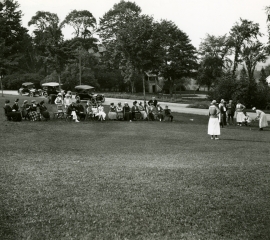Dean of Students, Kallgren, Dean of the College in 1943 to enable him to assume some of the President’s functions since Mr. Case often had to be away from the campus. The office of Assistant to the President was also established in 1943 and F. Reed Alvord, ’31, appointed to it; in 1945 he became Secretary of the University as well. To collect and preserve the University’s records and to supply information from them, Howard D. Williams, ’30, a member of the History Department, was appointed Archivist in 1947. The office of Dean of Faculty, abolished in 1934, was revived in 1945 with the appointment of Sidney J. French, Professor of Chemistry. The mounting burden of arranging for financial assistance and scholarships led to the creation of the position of Director of Student Aid to which William F. Griffith, ’33, was named in 1945; by 1957 he had become Dean of Admissions and Student Aid and was made Dean of Students a year later. The position of Vice-President for Development was established in 1958 and filled by Howard L. Jones, ’39, who had been Director of Development. Facilitating the work of these and other officers were the regular Administrative Staff meetings for discussion of problems and procedures which President Case instituted in 1942. Miss Gertrude E. Edgarton became the President’s Secretary also in 1942.
Anticipating the University’s post-war requirements, Mr. Case in 1943 appointed a faculty Committee on Needs and Resources and encouraged the Trustees and the Alumni Corporation to select similar groups; all three would cooperate in establishing a priority schedule of needs and canvass possible sources for meeting them. From this nucleus evolved the Development Council and the organization of a Development Office for which F. Gordon Boyce, ’39, became executive officer in 1946. Meanwhile, the annual Alumni Fund, thanks to the efforts of Carlton O. Miller, ’14, Alumni Secretary, and alumni workers throughout the country, had greatly increased goals which were met, making this resource most important in financing the University. Rapidly spiraling costs of all kinds gave special urgency to fund raising. With the blessing of the Committee on Needs and Resources, a successful drive was launched in 1947 to raise $250,000 for a Colgate infirmary and the Hamilton hospital. The most important single accomplishment was the Development Campaign begun in 1956 with an objective of $3,300,000 for raising faculty salaries, building a new library and an athletic center, and meeting operating costs of the








